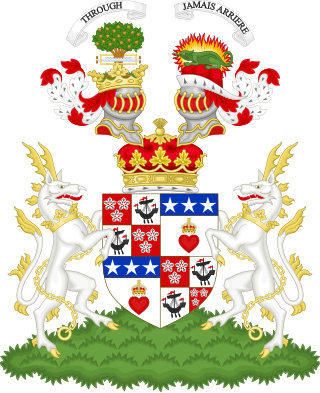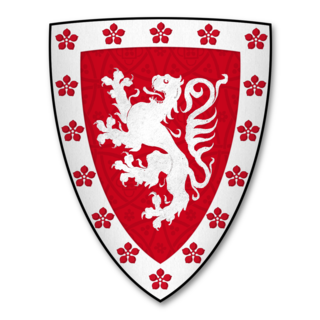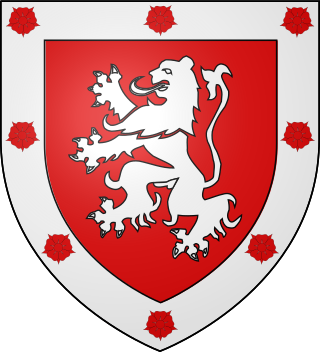Related Research Articles

Duke of Hamilton is a title in the Peerage of Scotland, created in April 1643. It is the senior dukedom in that peerage, and as such its holder is the premier peer of Scotland, as well as being head of both the House of Hamilton and the House of Douglas. The title, the town of Hamilton in Lanarkshire, and many places around the world are named after members of the Hamilton family. The ducal family's surname, originally "Hamilton", is now "Douglas-Hamilton". Since 1711, the dukedom has been held together with the Dukedom of Brandon in the Peerage of Great Britain, and the dukes since that time have been styled Duke of Hamilton and Brandon, along with several other subsidiary titles.

Lord Borthwick is a title in the Peerage of Scotland.

Patrick de Dunbar, 9th Earl of March, was a prominent Scottish magnate during the reigns of Robert the Bruce and David II.

The title Earl of Dunbar, also called Earl of Lothian or Earl of March, applied to the head of a comital lordship in south-eastern Scotland between the early 12th century and the early 15th century. The first man to use the title of Earl in this capacity was Gospatric II, Earl of Lothian, son of Gospatric, Earl of Northumbria. It descended to George de Dunbar, 11th Earl of March, whose titles & estates were declared forfeit by parliament in 1435, and retired into obscurity in England. His son Patrick retained a barony at Kilconquhar in Fife.

Thomas Randolph, Earl of Moray was a soldier and diplomat in the Wars of Scottish Independence, who later served as regent of Scotland. He was a nephew of Robert the Bruce, who created him as the first earl of Moray. He was known for successfully capturing Edinburgh Castle from the English, and he was one of the signatories of the Declaration of Arbroath.

James Douglas, the 4th Lord of Dalkeith, was created the 1st Earl of Morton in 1458.
Patrick IV, 8th Earl of Dunbar and Earl of March, sometimes called Patrick de Dunbar "8th" Earl of March, was the most important magnate in the border regions of Scotland. He was one of the Competitors for the Crown of Scotland.
William Cunningham, 4th Earl of Glencairn, 5th Lord of Kilmaurs was a Scottish nobleman, soldier, and "notorious intriguer".
Walter Steward of Dundonald was 3rd hereditary High Steward of Scotland and Justiciar of Scotia.
Robert Stewart, 1st Earl of Orkney and Lord of Zetland (Shetland) was a recognised illegitimate son of James V, King of Scotland, and his mistress Eupheme Elphinstone. Robert Stewart was half-brother to Mary, Queen of Scots and uncle to James VI and I of Scotland and England.
Sir John Bellenden of Auchnole and Broughton was, before 1544, Director of Chancery, and was appointed Lord Justice Clerk on 25 June 1547, succeeding his father Thomas Bellenden of Auchnoule. John was knighted before April 1544.
John Hay, 1st Lord Hay of Yester is the ancestor of the Marquesses of Tweeddale. He was created a Lord of Parliament on 29 January 1488 by James III of Scotland.

Sir William Borthwick, 3rd of Borthwick and later 1st Lord Borthwick was a Scottish peer and ambassador.

George de Dunbar, 10th Earl of Dunbar and March (1338–1422), 12th Lord of Annandale and Lord of the Isle of Man, was "one of the most powerful nobles in Scotland of his time, and the rival of the Douglases."
Sir Robert de Lawedre (Lauder) of Edrington & The Bass, Knt., was a Burgess of Edinburgh and a confidant of King Robert III and sometime Guardian of his son, the future James I of Scotland.
Alexander Cunningham, 5th Earl of Glencairn was a Scottish nobleman and Protestant reformer, prominent in the Scottish Reformation.
William Borthwick, 4th Lord Borthwick was a Scottish nobleman.
William Borthwick, 2nd Lord Borthwick was a Scottish landowner and ambassador to England.

Cranshaws Castle or Cranshaws Tower is a privately owned 15th-century pele situated by the village of Cranshaws in Berwickshire, Scotland. The building is still in use as a residence, and is protected as a category A listed building.

The Feudal Barony of MacDuff is a Scottish Feudal Barony in Macduff, Scotland, contained mostly within the boundaries of the Town of Macduff, in the Banff and Buchan area of Aberdeenshire, Scotland. Clan MacDuff traces origins to the historic, Lowland, Scottish Duff Clan. William Shakespeare's MacBeth has always played a role in the legend of Clan MacDuff, as few can determine the line between The Duff Family history and historical fiction. This ambiguity worked to the benefit of future MacDuff Barons, who were able to prove they were descended from the first Duff to receive a charter in Northeast Scotland. In 1404 David Duff received the charter, in Aberdeenshire, from Robert III of Scotland. In 1759, William Duff was granted the historic Celtic Title of “Fife”, further tying the Duffs of Northeast Scotland, with their ancient Lowland ancestors - the original Earls of Fife from the 11th century. William Duff had five sons - the eldest, James, would become the 2nd Earl Fife and the 1st Baron of MacDuff. James invested heavily in the village of Doune, or “Down”, across the River Deveron from Banff. He built a harbor there in 1760, which quickly became more successful than the harbor at neighboring Banff, which had been established much earlier. In 1783 a charter was granted by King George III, changing the name from Doune to Macduff in his favor and, although a lesser title than Earl, bestowing on him the dignity of the 1st Baron of Macduff.
References
- ↑ Pine, L.G., FSA Scot, &c.,The New Extinct Peerage 1884-1971, London, 1972: 32, ISBN 0-900455-23-3
- ↑ Anderson, William, The Scottish Nation, Edinburgh, 1867, vol.ii, p. 339, has him as being killed at the battle of Flodden but this is incorrect - see Complete Peerage and Pine (1972)
- ↑ Anderson, William, The Scottish Nation, Edinburgh, 1867, vol.ii, p. 339
- ↑ Foedera, xii, p. 241
- ↑ Bain, Joseph, FSA Scot, &c., Calendar of Documents Relating to Scotland, Edinburgh, 1888, vol.iv 1357-1509, addenda 1221-1435, no.1505, p. 308
- ↑ Bain, 1888, p. 418
- ↑ Anderson (1867), vol.ii, p. 339
- ↑ Pine, L.G., FSA Scot, &c.,The New Extinct Peerage 1884-1971, London, 1972: 32
- ↑ Nisbet, Alexander, A System of Heraldry &c., volume 2, 1722, facsimile edition, Edinburgh, 1984, Appendix, p. 106